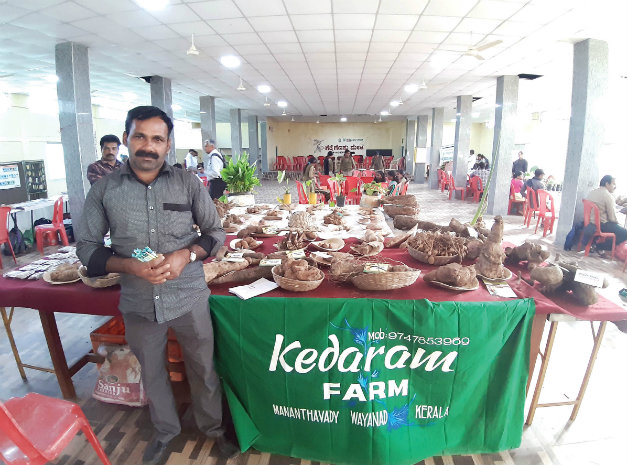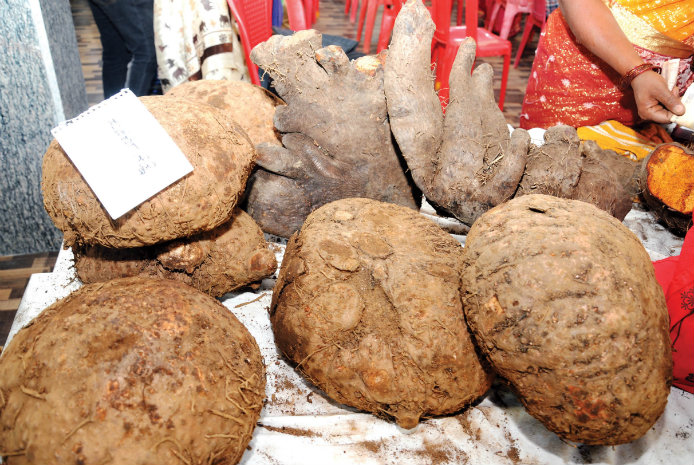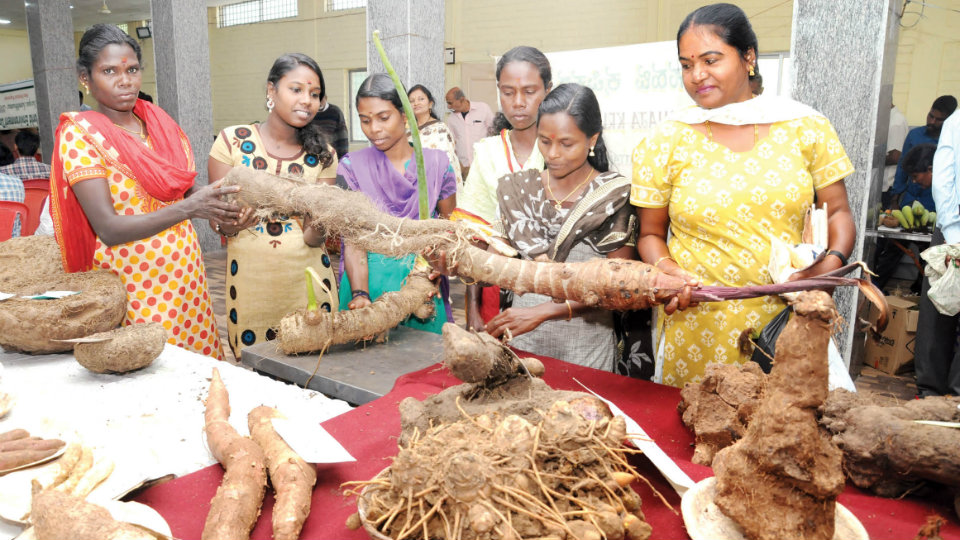By Stuti Ravikumar
Can there be a revival of interest in tubers, just like millets?
The response received by tubers at the two-day ‘Roots and Tuber Mela’ that began at Curzon Park yesterday promised a sort of revival of people’s interest in nutritious crops that are grown under the ground. The Mela is an eye-opener at a time when our knowledge of tubers is limited to carrots, beetroots, potatoes and at the most, sweet potatoes or tapioca.
More than 50 varieties of tubers were on display at the mela and a diverse range of potatoes, cassavas, sweet potatoes and yams were exhibited. Members of the tuber family like Makkalagesu weighing about 50 grams to yams weighing about 25-30 kgs awed the visitors.
A tuber is a swollen, underground stem of certain seed plants, in which is stored nutrients for its growth and reproduction. As the ubiquitous potato has eclipsed all its other cousins, consumption of tubers got restricted to tribal communities. While potato is vulnerable to pests and diseases, tubers form a special class of food and they are hard and have a long shelf-life.
Tubers are rich sources of carbohydrates, vitamins and minerals. They are rich in anti-oxidants and have anti-cancer properties and are safe to be consumed by people with diabetes and high blood pressure. On the agricultural side, they are easy to grow and are extremely adaptable to a wide range of climatic conditions. The Mela will conclude today evening.
At the Mela, there was a special visitor from Kerala – N.M. Shaji of Kedaram Tuber Conservation at Manandavadi in Wayanad. Shaji is a progressive farmer at Illathuvayal and has bagged the National Plant Genome Saviour Award for lifetime engagement in protecting genetic diversity of tuber crops.
Shaji’s 1.5-acre farm, Kedaram, has over 120 varieties of tubers including rare varieties recovered by the tribals from the deep forest. Travelling far and wide, he has collected as many tubers as he could. He soon filled his farm with rare varieties and started getting visits from other interested new generation farmers.

Star of Mysore caught up with Shaji and here is what he has to say:
Star of Mysore (SOM): Tell us about yourself and about the crops you grow and of course your tuber collection.
Shaji: I come from a family that is dedicated to agriculture. My grandparents, nearly centenarians, still work in our fields and so do my little children. I cultivate over 102 different varieties of edible tubers, many varieties of paddy, fruits and vegetables and medicinal plants. I am also into apiculture and pisciculture.
SOM: You are making the most of your 1.5-acre plot. We are curious to know about the history of tubers.
Shaji: The practice of cultivating or gathering tubers began with the Adivasis.
They used to work as Jeetas (bonded labourers) for their landlords. In return, they would receive one-ninth of the produce which was meagre for their survival. Thus tubers which were easy to cultivate became a staple in their lives.
SOM: How does the market look for tubers at present?
Shaji: Initially, we used to keep our tuber produce to ourselves. Now, awareness about tubers and their health benefits is rising. Their anti-cancer properties and various other benefits are making tubers popular. Many people, usually youngsters visit my farm to see my tuber collection and take home a few. A youngster valuing the knowledge of our ancestors makes me happy. Scientists, farmers, actors, college students, foreigners and famous personalities have visited my farm.
SOM: Do you practice organic farming techniques or use chemical fertilizers?
Shaji: I take pride in saying that I’m the only farmer in Manandawadi who does not use any chemicals in farms even though it’s made easily available by the Department of Agriculture. My produce is 100% organic.

SOM: How did last year’s floods in Kerala affect you?
Shaji: Floods badly hit my fields. There was water-logging for days. Just when I thought all my efforts had gone waste, I began to see sprouts shooting up from my submerged tubers. Tubers are fighters and they survive and never fail to give a good harvest.
SOM: Would you like to give our readers a message?
Shaji: Agriculture exists in our very roots. It is a way of life. Youngsters these days are busy aping the West. They should instead inculcate the values and ways of life passed on by our ancestors. We want our educated youth to stand by us like pillars of strength in improving the lives of farmers. We want the government to make more farmer-friendly policies.








Recent Comments